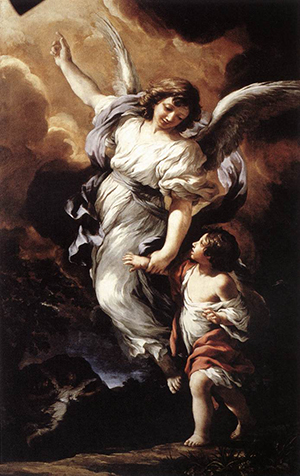Guardian Angels
Feast Day October 2

Here is a riddle for you: I am always with you, but you never see me. I am not God, but I was created by God. I protect and guide you. Who am I?
God gave us guardian angels to protect and guide us. Saint Jerome wrote that the human soul is so valuable in heaven that every human person has a guardian angel from the moment the person comes into being. These pure spirits, which we can neither see nor feel, play an important role in our lives. Jesus refers to them when he says, “Take care that you do not despise one of these little ones; for, I tell you, in heaven their angels continually see the face of my Father in heaven” (Matthew 18:10).

Angels are messengers from God. The word angel comes from the Greek word for “messenger.” In a very real way, these powerful spirits point out to us the ways of God. Guardian angels assist us in work or study. In times of temptation, these spiritual beings direct us to do good. Thomas Aquinas said that angels are the most excellent of creatures because they have the greatest intelligence next to God.
Perhaps the guardian angels are best known for protecting us from physical danger, but their main role is to care for the salvation of our souls. It is wonderful to know that God has promised to love, protect, and be with us always. One way he does this is through the care of the angels. Whenever you meet with danger or discouragement, your guardian angel is your personal, heavenly bodyguard. The angels also offer prayers to God for us. Because angels always see and hear God, they can intercede for us. We should love our guardian angels, respect them, and pray to them.
In early Christianity there was no feast for the guardian angels, just one for the archangels. But in the 15th and 16th centuries, the feast of the Guardian Angels was unofficially celebrated in Austria, Spain, and Portugal. In 1608 Pope Paul V made it a universal feast. In doing so, he helped to make us aware of the guardian angels, not just one day in October, but every day of our lives.
Image credit: The Guardian Angel by Pietro da Cortona, 1656. Public Domain via Wikimedia.

